
Example Local SEO Strategy
We’ve all heard the saying, “failing to plan is planning to fail” and this is especially true of search marketing. Given the wide range of tactics required to improve your local search visibility, having a documented local SEO plan is non-negotiable if you’re serious about attracting more local consumers to your business.
What is a local SEO strategy?
Think of your local SEO strategy as a blueprint for success. It maps out everything you need to do to build a stronger local search presence, using a range of local SEO best practices.
Creating a local SEO strategy can take some time, but as you will refer to it continuously to help you outrank other local businesses, the time and resources you invest in getting this right at the start will pay dividends later on.
A good strategy should cover:
- Your present situation: What keywords are you ranking for? What local SEO activity (if any) are you already working on?
- Competitor research: who’s performing better than you in search and what are they doing that you aren’t?
- Opportunities for improvement: Where do gaps in your current SEO activity exist and how can your site be better optimized?
- Plan of action: A list of tactics that you’ll need to deploy to boost your local search presence.

94% of high-performing multi-location businesses have a dedicated local marketing strategy
How do I create a local search strategy?
Any type of local business hoping to attract more local consumers needs a strategy in place to guide their actions and ensure time and resources are being allocated in the most effective manner.
However, building out a strategy for the first time can feel overwhelming, not least because there are so many local SEO ranking factors to consider. A methodical approach is best, allowing you to tackle each element in your plan thoroughly while also ensuring that you don’t miss any local SEO best practices that could transform your results and see your site ranking higher across the Local Pack, Local Finder, Maps and local search results.
Step 1: Your Present Situation
Before you can decide which SEO tactics will serve you best, you need to understand where your site is ranking and how it’s performing right now. An audit is the best way to build an objective and data-led view and will flag up any urgent tasks that should be prioritized before other local SEO work takes place.
The easiest way to complete the audit process and gather as much useful, accurate, and up-to-date information as possible is to use a tool such as Local Search Audit.
If you’re going to conduct a manual audit, you’ll need to:
- Create a keyword ranking report, showing which keywords you’re ranking for along with their local search position.
- Review your on-page optimization. Pay particular attention to any issues which could impede your local SEO progress such as missing and inaccurate page titles, slow loading pages, broken links, duplicate and low-quality content, and a poor user experience from mobile search.
- Review your Google Business Profile (formerly known as Google My Business) to understand where gaps in optimization exist.
- Create a link report showing inbound links to your page, along with anchor text.
- Study your online reviews, paying attention to how many positive and negative reviews you currently have, which platforms the reviews appear on and whether or not you’re responding in a timely manner.
- Create a list of local citations, noting any with incorrect or outdated information.
Step 2: Competitor Research
Your competitors are likely to be a very useful source of local SEO intel. The local businesses appearing higher than you in search are likely there because they’re doing a better job of implementing local SEO best practices on a regular basis. Taking the time to understand what they are doing well and which tactics they’re deploying will give you a useful starting point for your own strategy.
For a thorough analysis, you can repeat step one above but, this time, focus on specific competitors, follow our suggestions here or, use a tool like Local Search Audit to do the heavy lifting for you.
Learn more: How to perform local competitor analysis
Step 3: Opportunities For Improvement
Steps one and two should give you a very clear idea of where your site stands, how it’s performing now, what you’re doing well, where you’re falling down and how competitors are outranking you.
Now, you can use this data to pinpoint specific areas where opportunities for improvement exist and use this to begin populating your local SEO strategy. If your on-page audit revealed that your site is populated with poor or outdated content, for example, creating more useful and valuable content for a local reader should form part of your plan.
Likewise, if your competitor analysis confirmed that your rivals are doing a much better job at replying to Google reviews, you’ll want to ensure that your strategy includes more time for review management.
Armed with all of this information, it’s now time to formulate your local SEO strategy.
Sample Local SEO Strategy For a Small Business
To help you get your local SEO plan down on paper, we’ve chosen a small business at random and outlined a suitable local SEO strategy. Use this as your framework for creating your own strategy.
This business is a unisex barbershop in San Francisco. As you’ll see, any identifying information has been blurred out.
Google Business Profile
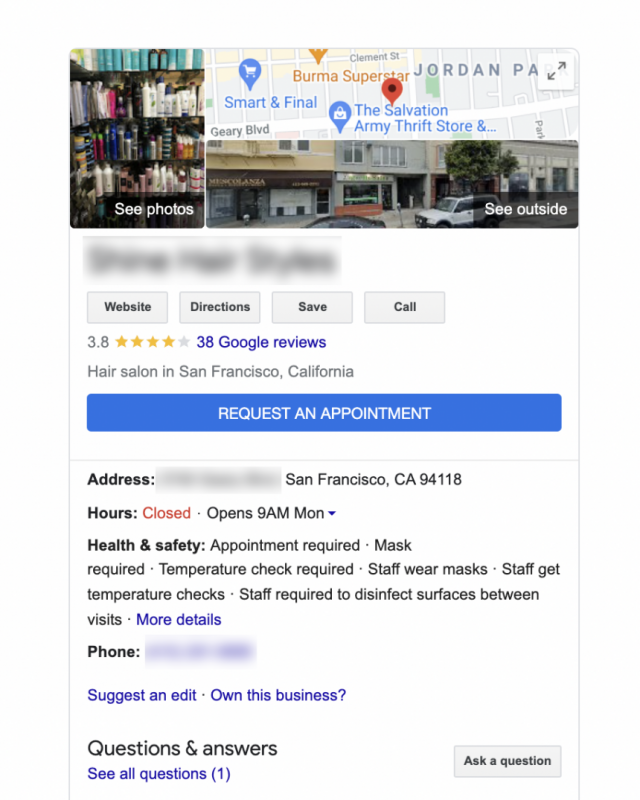
Although this business has claimed its listing, there are a number of ways that it could improve its use of this local marketing tool, including:
- Adding more photos
- Publishing Posts
- Asking and answering questions
- Adding more business information
Photos
No new photos have been added to the profile since 2017. This could give the impression that the business has closed or indicate that the business is not active online.
The photos that can be seen are predominantly of hair products, whereas potential customers are more likely to want to see examples of different haircuts and styles.
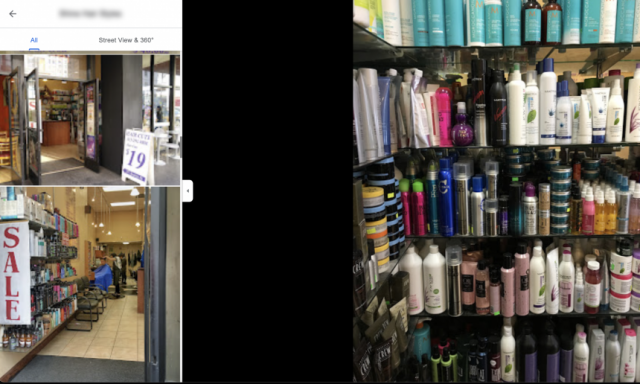
By regularly adding new and helpful photos, the business could highlight the skills of the people who work there and show customers what to expect. Before and after images of a restyle for example could be useful for a potential customer.
Posts
The business isn’t using GBP Posts to share news and updates. This is a missed opportunity to connect with customers and push promotional offers. Posts are also a great way to share new information on products and services, and to make other announcements such as competitions, late availability appointments, and new team members.
Although using Google Posts likely doesn’t improve local search rankings, it can help businesses to attract attention and, therefore, earn new customers.
Q&A
A potential customer has asked a question through the Q&A section but the business hasn’t responded. Similar to the previous point on photos, this could lead a potential customer to assume the business is closed, or that it doesn’t prioritize customer service.

Responding to customer questions is a quick and easy way to build relationships and share information. The business can also ask questions itself and answer them. Using this tool to have a list of FAQs can be useful for the local consumer by giving them more information to aid in decision making.
Business Information
The business address listed on Google doesn’t match the address listed on the company website. This could be confusing to customers and also sends mixed signals to Google, which could be harmful to search rankings. Ensuring NAP is consistent across the web begins with the content that the business can control, such as its own website, Google Business Profile, and social media profiles.
Local Link Building
In order to build local links, this business should be reaching out to other local businesses in San Francisco, especially those within the hairdressing and beauty industries.
Launching a blog on the website would be a powerful way to start building the authority of the site and earn links. The business could also get valuable local links by creating local citations.
Citation Building
This barbershop has created citations on a number of sites, including:
- Yelp
- Foursquare
- Better Business Bureau and
- MapQuest
Although the business has built some citations, they aren’t all being consistently managed or maintained. For example, the business has been reported as closed on Yelp, and the business hasn’t rectified this:
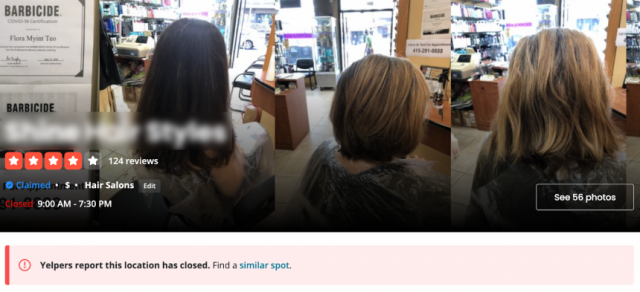
Note: There is nothing to indicate that this business has closed. The business website has been updated in the last few weeks and recent reviews have been left, so it seems unlikely that this is true.
Additionally, the prices listed on various business directory sites don’t match the prices from the business website.
Discrepancies in business information across the web don’t create a good impression for potential customers and are also harmful to local SEO.
Spam Fighting
Several Google Business Profiles in the same category are using spammy practices to boost their rankings, and a number of them are outranking the business in question.
For example, a number of businesses are using the words ‘barbershop’, and ‘barbers’ in their GBP name, even though these words aren’t in their actual registered business name.
The business in question could spend some time reporting these spam listings to get a boost in rankings.
Website Optimization
Although a great deal of local SEO is specific to Google Business Profile, there’s still much to be gained by having a strong website. The localized organic results are made up of websites, and this is still an important source of traffic for local businesses.
There are several ways that this business can optimize its website. The areas to address include:
- the reviews page
- social links
- keyword research and
- image optimization
Reviews Page
The site has a dedicated page for reviews, but only four reviews are featured:
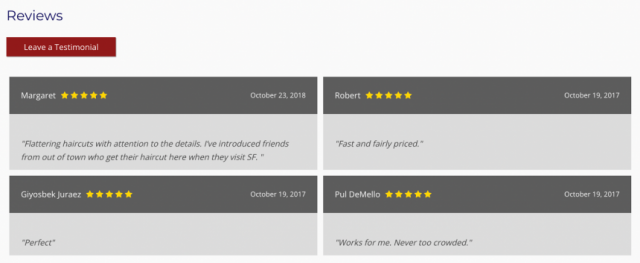
Given that the business has hundreds of positive reviews across multiple platforms, this is a missed opportunity to showcase this feedback. The reviews listed are also several years old, which will likely not encourage a potential customer to use the business.
In fact, only highlighting a very small number of old reviews could actually be harmful to the business’s reputation. This is because a user might assume they don’t have more positive, recent reviews to share. Embedding review widgets on the website to lead visitors to review platforms would be an easy way to ensure that a full range of relevant reviews is easily accessible to potential visitors, without the business needing to make timely manual updates.
Social Links
The website links to a Facebook account that hasn’t been used since 2016 and only has eight followers.
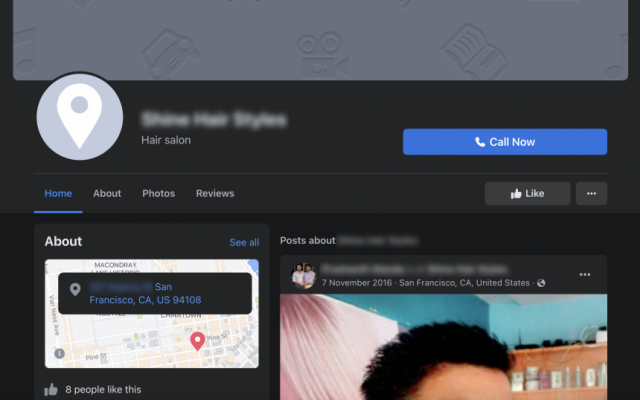
The website also links to the company’s YouTube channel, which has only one video from four years ago.
This lack of activity might give somebody the impression that the shop is closed and cause them to look elsewhere.
This business isn’t using any other social platforms, which means they’re missing out on reaching new audiences. Instagram is a particularly great place for barbershops to promote themselves for free.
If the business were to create an Instagram account, then it could be connected to the website to automatically feature new photos and videos there. This would demonstrate the expertise of the staff, and also show potential customers that the business is active—both online and offline.
Keyword Research
The website for this business ranks for approximately 200 different keywords. However, the only search term on the first page is the exact match term for the business name. The remaining keywords rank on page two and beyond. The amount of monthly traffic to the website is estimated to be very low.
It’s likely that the business hasn’t done much (if any) keyword research to inform the content used on the website.
There are typically around 1,000 searches per month for ‘barber san francisco’, and 720 searches for ‘best barbershop san francisco’. It’s evident that ranking on the first page for these search terms, and similar terms, would be advantageous.
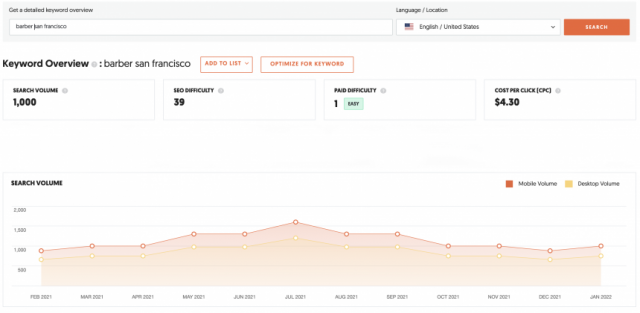
Creating a keyword-informed content strategy and using it to launch a blog could soon help to get this website ranking well in the localized search results.
Image Optimization
Several different images are used across the business website, but none of them are properly labeled or optimized. As you can see from the image below, the photos have generic file names, which have no SEO value.
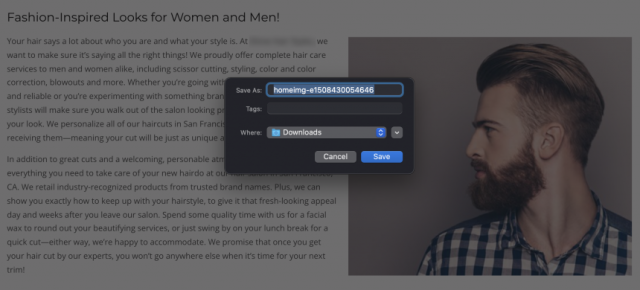
By using data from keyword research for the file names, the business could target relevant search terms through its images. This is a simple fix and could give the website a boost in the rankings.
Reviews
The business doesn’t appear to have responded to any customer reviews across multiple platforms in the last few years, such as GBP, Yelp, or Facebook.
Given that the business has several negative reviews, this is a huge, missed opportunity to salvage its reputation and rebuild these relationships. It’s also a lost chance to say thank you to those who left positive reviews to encourage repeat custom.
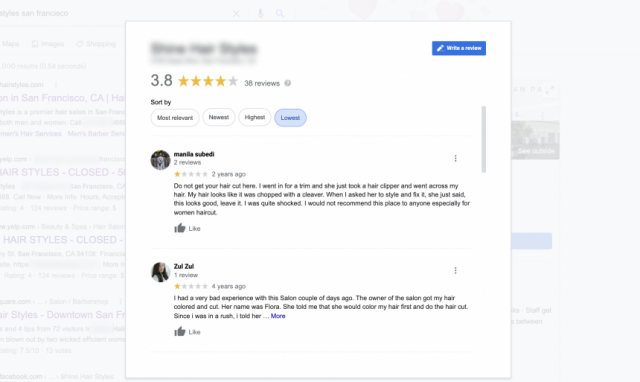
In Summary
Although this business seemingly has a lot of happy customers, there’s a lot more that it could be doing to enhance its online presence. Addressing the issues mentioned here with the help of a documented local SEO strategy would help the business build a better reputation and potentially drive business growth.